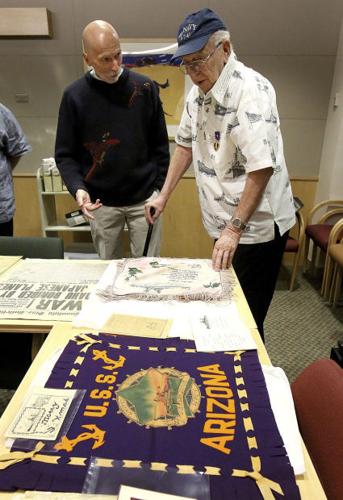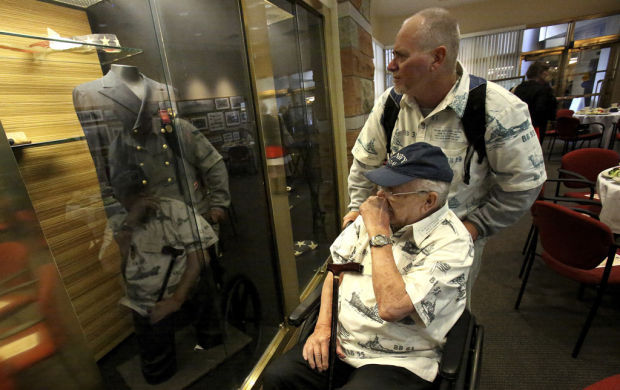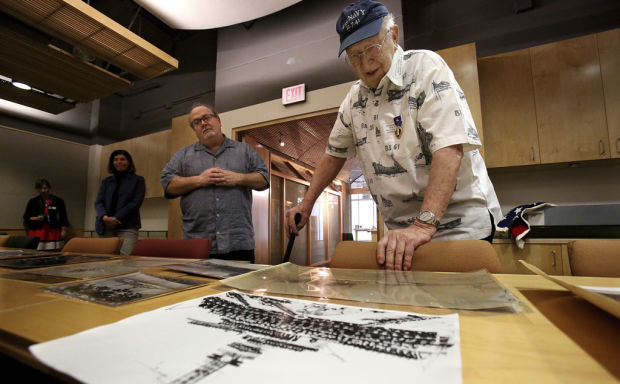President Franklin Delano Roosevelt said the date would live in infamy.
Dec. 7, 1941, 72 years ago today, changed the course of history. Events of that day were seared into the collective memory of Americans for generations to come.
For Lauren Bruner, remembrances of the attack on Pearl Harbor were burned onto his very body.
Now 93, Bruner was a 21-year-old fire controlman petty officer aboard the USS Arizona the day the Japanese attacked Pearl Harbor, killing 2,402 people.
Bruner was gravely injured in the bombing, receiving burns to more than 70 percent of his body.
He was in Tucson this week to commemorate the 72nd anniversary of the attack and to speak with groups of University of Arizona students and veterans. Bruner also viewed the collected USS Arizona memorabilia held at the UA Library’s special collections.
He is one of a handful of surviving crewmen from aboard the ship that day, and still makes trips to the annual reunion events.
“I’ve been to every one of ’em,” he said. Every one since about 1990, that is.
That’s when his sister-in-law saw someone in Palm Springs, Calif., with a USS Arizona reunion bumper sticker on his car. She flagged down the driver and asked for the details.
But even now, more than 70 years since that tragic day, Bruner rarely talks about what he saw when he witnessed one of the most historically significant events of the last century.
Bruner has confided in author Ed McGrath, though, who traveled with him from his California home for the memorial events.
“He’s a real American hero,” McGrath said.
McGrath has been working with Bruner on a documentary film and book about his USS Arizona experiences.
In McGrath’s telling, Bruner’s survival was fate.
When the call went out to man the battle stations that morning, Bruner ran to his post on the ship’s superstructure high above the deck.
He had been below deck getting ready to attend church services that calm Sunday morning as Japanese warplanes dropped bombs across the harbor, eventually sinking six U.S. ships, damaging 13 others and destroying 188 aircraft.
After three direct hits, a fourth bomb pierced the Arizona’s deck and cascaded toward an ammunition magazine. Seconds later, the ship erupted in a ball of fire and black smoke.
Archival photos and videos show the bow of the Arizona almost completely engulfed in a fiery blast hundreds of feet high.
The steel floor of the platform above the bridge likely spared Bruner and his crewmen the worst of the blast, although flames still scorched much of his body.
But surviving the explosion was just the start.
Burning oil blazed on the water all around the ship.
Crewmen from the nearby USS Vestal threw Bruner and compatriots a line, which they used to hoist a rope to the roost. They affixed the rope to the superstructure, still more than 60 feet above the deck, then climbed down to the safety of the Vestal.
In all, 1,177 of the 1,512 sailors aboard the Arizona were killed.
Bruner spent two months in the hospital ship USS Solace and several more in Navy hospitals.
It was this daring escape that give McGrath the name of the book and film project: “Second to the Last to Leave.”
Through his research, McGrath said, he learned that Bruner was indeed the second to the last man off the burning and sinking Arizona.
Although terribly injured, Bruner’s naval service was far from over.
He later joined the crew of the newly launched destroyer the USS Coghlan, where he spent the remainder of the war fighting the Japanese from the Aleutian Islands to the Philippines.
Despite the tragedy, Bruner said he still looks back fondly at his days on the Arizona and in the Navy.
He recalled sporting events he and other sailors used to participate in or chasing girls in the bars around the island.
“For a nickel you could get a can of beer,” Bruner said, describing how he and other sailors spent much of their $21-per-month salaries.
At 93, Bruner said he still enjoys traveling to the World War II reunion events, especially those to commemorate the USS Arizona.
“A lot of people have been coming for years and years who had nothing to do with the Arizona. They just wanted to be friends,” he said. “We have a great following.”
McGrath plans to premiere the documentary about Bruner on Dec. 7, 2014, at the USS Arizona Memorial in Pearl Harbor. With luck, Bruner will attend, too.







